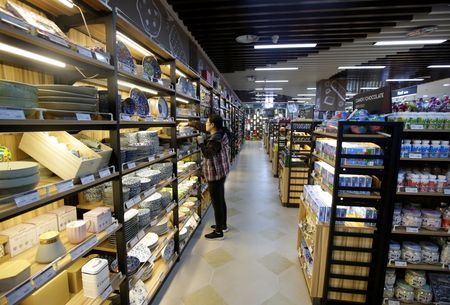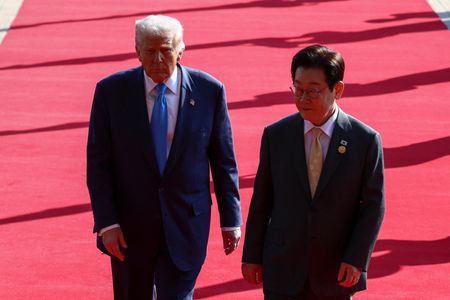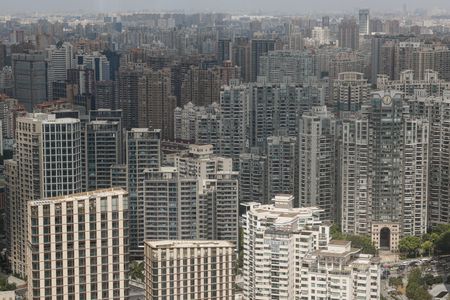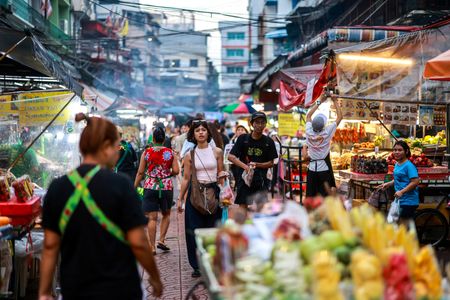BEIJING (Reuters) -China’s factory output and retail sales grew at their weakest pace in over a year in October, piling pressure on policymakers to revamp the $19 trillion export-driven economy as mounting supply and demand strains threaten to further curtail growth.
For decades, officials charged with keeping the world’s second-largest economy humming have had the option of spurring its vast industrial complex to boost exports should consumers tighten spending at home, or reaching into the public purse to fund GDP-boosting infrastructure projects.
But U.S. President Donald Trump’s tariff war is providing a stark reminder of the manufacturing juggernaut’s reliance on the world’s largest consumer market, and even an economy of China’s size can only squeeze so much growth from building more industrial parks, power substations and dams.
Friday’s indicators gave little hope for a quick turnaround, and the worse the data gets month after month, the more urgent the need for reform becomes.
Industrial output grew 4.9% year-on-year in October, National Bureau of Statistics (NBS) data showed, the weakest annual pace since August 2024, compared with a 6.5% rise in September. It missed a 5.5% increase forecast in a Reuters poll.
Retail sales, a gauge of consumption, expanded 2.9% last month, also their worst pace since last August, easing from a 3.0% rise in September, compared with a forecast gain of 2.8%.
“China’s economy is facing pressures from all sides,” said Fred Neumann, chief Asia economist at HSBC.
“The strong lift from exports that supported growth in recent quarters will be hard to sustain into next year, even if U.S. import tariffs now turned out lower than feared. That leaves domestic demand to pick up the slack, but without significant further stimulus, it will be hard to reverse recent slowing in both investment and consumption,” he added.
Policymakers acknowledge the need for change to address historical supply-demand imbalances, lift household consumption and tackle towering local government debt that keeps provinces — many with economies the size of nations — from being self-reliant.
All the same, they also recognise structural reform will be painful, and is fraught with political risk at a time when Trump’s trade war has ramped up pressure on the economy.
China’s exports unexpectedly crumbled in October, separate data showed last week, as producers struggle to turn a profit in other markets after months of front-loading to beat Trump’s tariff threats.
Surprisingly, China’s car sales also snapped an eight-month growth streak, despite expectations that purchases would accelerate ahead of the phase-out of various tax breaks and government subsidies. That’s worrying as the fourth quarter is typically the strongest for auto sales, and the slump came even with an extra day due to a national holiday this October compared with 2024.
ECONOMY UNDERMINED BY STRUCTURAL ISSUES
Fixed asset investment shrank 1.7% in the first 10 months of the year from the same period last year, compared with an expected 0.8% drop. It had shrunk 0.5% over the January-September period.
And a protracted slowdown in the nation’s crucial property sector, a key store of household wealth, showed no sign of abating, with new home prices falling at their fastest monthly pace in a year.
“I am a bit concerned about investment. Although China is moving to a more consumption-led model, that should not result in no investment,” said Xu Tianchen, senior economist at the Economist Intelligence Unit.
China’s ruling Communist Party met last month to chart the country’s economic course for the next five years, pledging to lift household consumption’s share of GDP “significantly” while also stressing the need to reinforce its vast industrial base.
That has some economists speculating whether Beijing will likely be tempted again to take the path of least resistance, reaching for its usual playbook of channelling resources to large firms while bypassing private producers and households.
Infrastructure investment, they note, will be a quicker way for Beijing to ensure the economy hits the official annual growth target of “around 5%”.
“Come 2026, generous government subsidies will still be needed. Structural issues are dragging down growth, and the base will be higher,” the EIU’s Xu said.
(Reporting by Joe Cash; Additional reporting by Ellen ZhangEditing by Shri Navaratnam)











